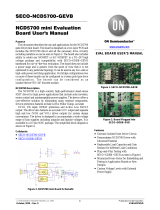
4. Bill of Materials
Table 4.1. Si8285/86-EVB Bill of Materials
Part Reference Description Manufacturer Manufacturer Part
Number
C1, C11 CAP, 10 μF, 16 V, ±10%, X5R, 0805 Venkel C0805X5R160-106K
C2, C6, C12 CAP, 0.1 μF, 16 V, ±10%, X7R, 0402 Venkel C0402X7R160-104K
C3 CAP, 390 pF, 100 V, ±20%, X7R, 0805 Venkel C0805X7R101-391M
C4, C13, C16 CAP, 0.1 μF, 50 V, ±10%, X7R, 0603 Venkel C0603X7R500-104K
C5, C7, C14, C15 CAP, 10 μF, 25 V, ±20%, X6S, 0805 Venkel C0805X6S250-106M
C10 CAP, 100 pF, 200 V, ±5%, NP0 HIGH Q, 0805 Venkel C0805HQN201-101J
D1, D2, D4, D5 LED, RED, 631 nM, 20 mA, 2 V, 54mcd, 0603 LITE-ON TECHNOLOGY
CORP
LTST-C190KRKT
D3, D6 DIO, FAST, 300 V, 1.0A, SMA Fairchild ES1F
J1, J2, J4, J5 Terminal Block, 2 pos, 6.35 mm, 10-30AWG, 300 V, 32 A Phoenix Contact 1714955
J3, J6 Terminal Block, 3 pos, 6.35 mm, 10-30AWG, 300V, 32 A Phoenix Contact 1714968
J7, J8, J9, J10, J11,
J14, J15, J16, J17
Header, Single Pin, Tin Plated Samtec TSW-101-07-T-S
R1, R2, R6, R7, R8,
R9, R12
RES, 10 K, 1/16 W, ±1%, ThickFilm, 0603 Venkel CR0603-16W-1002F
R13
R3, R10 RES, 100 Ω, 1/10 W, ±1%, ThickFilm, 0805 Venkel CR0805-10W-1000F
R4, R5, R11 RES, 10 Ω, 1/4 W, ±1%, ThickFilm, 1206 Venkel CR1206-4W-10R0F
SF1, SF2, SF3, SF4 HDW, BUMPON CYLINDRICAL, 0.312 x 0.215, BLK 3M SJ61A6
TP1, TP2 TESTPOINT, WHITE, PTH Kobiconn 151-201-RC
U1 IC, 4 AMP ISODRIVER, 12 V UVLO, 5KV, SOW16 SiLabs Si8285CD-IS
U2 IC, 4 AMP ISODRIVER, 12 V UVLO, 5KV, SOW16 SiLabs Si8286CD-IS
UG169: Si8285/86-EVB User's Guide
Bill of Materials
silabs.com | Smart. Connected. Energy-friendly. Rev. 0.1 | 9














